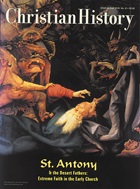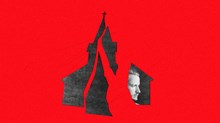The Roman philosopher Celsus warned his second century audience that if the "seditious rebels" called Christians were allowed to prosper, they would threaten not only ancient pagan tradition but the entire Roman order. "If everyone were to do the same as you Christians," he wrote, "there would be nothing to prevent the emperor from being abandoned, alone and deserted, while earthly things would come into the control of the most lawless and savage barbarians."
Celsus did not get it exactly right, but by the middle of the fourth century, Christians were indeed helping create a new world order. Crucial doctrinal and political battles were fought by fierce competing factions, and some of the key players were the new "martyrs," monks and hermits who had "died" to self and to the world. They opposed and attacked—sometimes physically—any authority they deemed unrighteous.
Ariomaniacs
The political influence of monks was most obvious in Egypt. Even Antony, despite being a hermit and a teacher of semi-eremetic monasticism, helped shape the larger theological movements of this day. In the Arian controversy (Arius denied the divinity of Christ), he stood with the orthodox side at a time when the imperial court was Arian-dominated. It was among Egyptian monks like Antony, in fact, that Athanasius (c.296-373), bishop of Alexandria, found protection for five years when the secret police of the Emperor Constantius II, an Arian, sought to arrest him.
At one point, according to Athanasius, Antony traveled to Alexandria and "denounced the Arians, saying that their heresy was the last of all and a forerunner of Antichrist." He even called the heretics "madmen" ("Ariomaniacs" in one translation). Despite the efforts of the Arian Emperor Valens (364-378) to destroy pro-Nicene monasticism in Egypt, pro-Nicene monks only grew in influence. The Christian historian Sozomen wrote that, "The monks were prepared to subject their necks to the sword rather than to swerve from the Nicene doctrines."
International politics
With the help of pro-Nicene Theodosius I, Nicene orthodoxy won in 381 at the Council of Constantinople. Theodosius then began a campaign to hinder paganism in the empire, and the desert monks became key players in this campaign.
When the emperor outlawed polytheistic rites in 391, the bishop of Alexandria, Theophilus (reigned 385-412), confiscated pagan properties, especially the Temple of Sarapis, the most sacred site of Greco-Roman Alexandria. Seeing that the pagan population would not go down without a fight, Theophilus requested imperial troops for assistance and, according to one ancient source, "summoned some fathers to go to Alexandria one day, to pray and to destroy the heathen temples there."
When the monks arrived, they tore down the Serapeum and other smaller temples. Such heavy-handed tactics, as well as his program to build grand churches in place of the old pagan temples earned this bishop his nickname, "church pharaoh" of Egypt.
These monastic allies, however, were not easy to control. In 399 Theophilus found himself in trouble with the monks when he publicly defended the teachings of Origen (whom opponents said denied the importance of created matter, among other things). One source says, "The majority of the fathers (at Scetis) decreed that … the bishop ought to be abhorred by the entire body of the brethren as tainted with heresy of the worst kind." In anger the monks left their monasteries and again marched to Alexandria, "where they excited a riot against the bishop … and threatened to put him to death."
Theophilus tried to calm the mob, saying, "When I look upon you, it is as if I beheld the face of God." He was forced to change his views on Origen to save both his office as well as his life.
For personal and political reasons, Theophilus took up the anti-Origenist cause with a vengeance, and he enlisted the monks to help him. He condemned defenders of Origen, such as Isidore, four monks known as the "Tall Brothers," and various pro-Origen church officials in Egypt. He removed many "heretics" (as he called them) from office and expelled the Tall Brothers from their monastic houses. He also sowed division in monastic communities, so that, as Sozomen put it, "A terrible contention prevailed among the monks, for they did not think it worthwhile to persuade one another … but settled down into insults."
The Tall Brothers fled to Constantinople and asked for justice from Emperor Arcadius (r.395-408) and Archbishop John Chrysostom (c.347-407). As archbishop of Constantinople, Chrysostom had the right to settle a dispute in Alexandria, so he called for a fact-finding hearing.
Theophilus arrived in Asia Minor in 403 to defend himself against the charges of Tall Brothers—and to seek revenge on Chrysostom. Some years earlier, Chrysostom had been appointed archbishop in place of Theophilus's candidate; in addition, Theophilus was furious that the see of Constantinople had recently been raised in status over the see of Alexandria.
So Theophilus gathered 36 allies, mainly bishops from Egypt and a few disgruntled locals (who had been subject to one of Chrysostom's denunciations). They met at the Palace of the Oak, outside of Chalcedon, at a "synod," and condemned the Tall Brothers and Chrysostom. With the support of the emperor (whose wife Chrysostom had recently likened to Jezebel in a sermon), Chrysostom was exiled.
Sozomen wrote that the people of the capital, who loved the archbishop, "ran to the churches, to the marketplaces, and to the palace of the emperor, and with howls and groans demanded the recall of John." Theophilus was forced to flee and Chrysostom was recalled from exile. When a second exile was successfully orchestrated in 404, John's allies, which included many monks, were also severely suppressed. Ironically, the Tall Brothers, who had been at the center of the original controversy, faded off into history.
Physical monasticism
Monkish politics surfaced again with the consecration of Cyril to the Alexandrian bishopric in 412. He was a brilliant theologian determined to continue his uncle Theophilus's policies. Cyril worked to rid Egypt of heretics, Jews, and pagans, often using heavy-handed methods such as inciting a mob against Hypatia (c.375-415), one of the last, great pagan philosophers of Alexandria. Such efforts brought him into alliance with one of the most important monastic leaders of the time, Shenouda (c.348-466), abbot of the Great White Monastery in Atripe, Egypt.
Raised in a monastery, Shenouda became a vibrant, strict, and successful governor over a community that eventually included thousands of men and women. When foreign brigands, called the Blemmyes, attacked upper Egypt, Shenouda offered refuge to the population. He also protected Christians from economic and political abuses by pagans, who still retained control of the region.
His power was such that when unhappy monks called upon secular authorities to intervene, Shenouda personally beat and kicked the leading magistrate and had loyal followers assault the magistrate's companions. Shenouda went so far as to attack the homes of wealthy polytheists as well as destroy their temples, their idols, and their private shrines.
Once he struck an opponent on the head and dragged the man to the Nile for baptism. Witnesses proclaimed Shenouda to be "the authority of God … sent to take vengeance upon that impious Greek."
Shenouda eventually gained prominence along the entire length of the Nile. While Shenouda was independent of Cyril's authority, he supported the bishop's efforts to make Egypt a thoroughly Christian region. Shenouda reportedly announced to some opponents, "I shall make you acknowledge … Cyril, or else the sword will wipe out most of you, and … those of you who are spared will go into exile." This alliance with Cyril, as well as Shenouda's powerful personality, won him an invitation to the ecumenical council of Ephesus, which condemned Nestorius for teaching that Christ has two persons (versus one person with two natures).
The monks, staunch and often audacious Christians, could be compliant or dangerous, depending upon the ebb and flow of any given controversy. The emperor Theodosius tried in 390 to limit their influence by bringing them under greater imperial control, and the great Byzantine emperor Justinian tried to do the same in 519. Both were only partially successful, because these monks, as the new martyrs, could never be entirely controlled. They insisted that righteousness, as they understood it, prevail.
Kenneth Calvert is a professor of history at Hillsdale College (Michigan), and he dedicates this article "to Dr. Nigel Kerr, a true Doctor of the Church."
For more information on this topic, see:
Chapter 37; The Decline And Fall Of The Roman Empire
http://www.ccel.org/gibbon/decline/volume1/chap37.htm
Catholic Encyclopedia: Origen And Origenism
http://www.csn.net/advent/cathen/11306b.htm
Catholic Encyclopedia: St. John Chrysostom
http://www.csn.net/advent/cathen/08452b.htm
Copyright © 1999 by the author or Christianity Today/Christian History magazine.
Click here for reprint information on Christian History.

Support Our Work
Subscribe to CT for less than $4.25/month






























